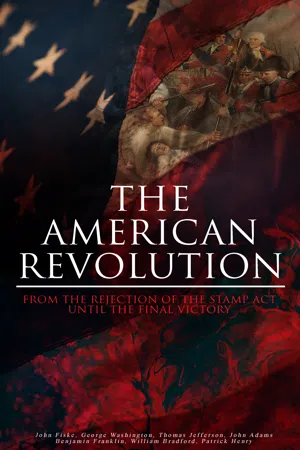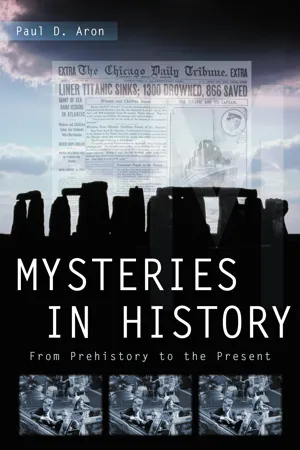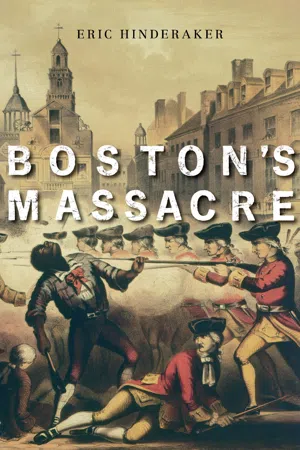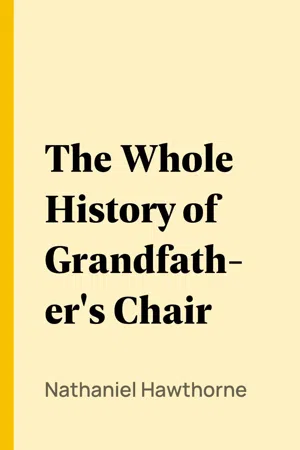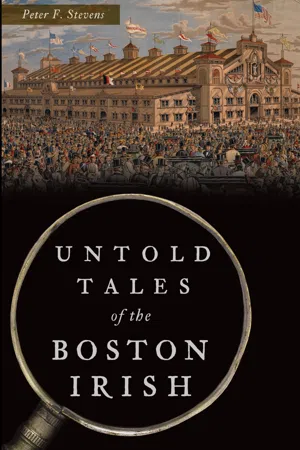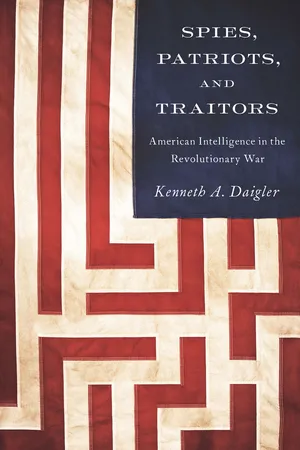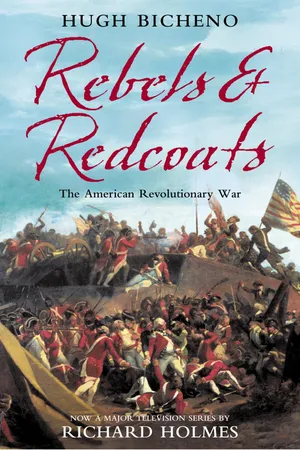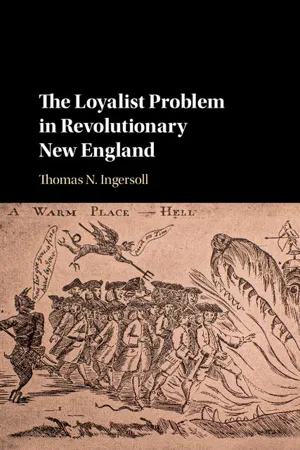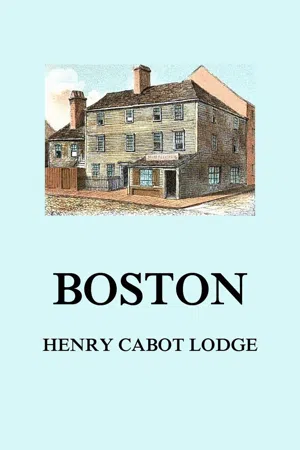History
Boston Massacre
The Boston Massacre was a violent confrontation on March 5, 1770, between British soldiers and a crowd of colonists in Boston, Massachusetts. The incident resulted in the death of five colonists and heightened tensions between the American colonies and Britain, ultimately contributing to the outbreak of the American Revolutionary War.
Written by Perlego with AI-assistance
Related key terms
1 of 5
11 Key excerpts on "Boston Massacre"
- eBook - ePub
The American Revolution: From the Rejection of the Stamp Act Until the Final Victory
Chronicles of Rebellion and Founding Documents of a Nation
- John Fiske, George Washington, Thomas Jefferson, John Adams, Benjamin Franklin, William Bradford, Patrick Henry(Authors)
- 2019(Publication Date)
- Madison & Adams Press(Publisher)
From that day forth the fourteenth and twenty-ninth regiments were known in Parliament as “the Sam Adams regiments.” PAUL REVERE’S PLAN OF KING STREET IN 1770 (Used in the trial of the soldiers) OLD STATE HOUSE, WEST FRONT Such was the famous Boston Massacre. All the mildness of New England civilization is brought most strikingly before us in that truculent phrase. The careless shooting of half a dozen townsmen is described by a word which historians apply to such events as Cawnpore or the Sicilian Vespers. Lord Sherbrooke, better known as Robert Lowe, declared a few years ago, in a speech on the uses of a classical education, that the battle of Marathon was really of less account than a modern colliery explosion, because only one hundred and ninety-two of the Greek army lost their lives! From such a point of view, one might argue that the Boston Massacre was an event of far less importance than an ordinary free fight among Colorado gamblers. It is needless to say that this is not the historical point of view. Historical events are not to be measured with a foot-rule. Some lessons of the “Massacre” This story of the Boston Massacre is a very trite one, but it has its lessons. It furnishes an instructive illustration of the high state of civilization reached by the people among whom it happened,—by the oppressors as well as those whom it was sought to oppress. The quartering of troops in a peaceful town is something that has in most ages been regarded with horror. Under the senatorial government of Rome, it used to be said that the quartering of troops, even upon a friendly province and for the purpose of protecting it, was a visitation only less to be dreaded than an inroad of hostile barbarians - eBook - PDF
Mysteries in History
From Prehistory to the Present
- Paul D. Aron(Author)
- 2005(Publication Date)
- ABC-CLIO(Publisher)
207 RT 6 A GE OF R EVOLUTIONS , 1750–1914 3 www.abc-clio.com ABC-CLIO 1-800-368-6868 What Started the Boston Massacre? D espite a foot of snow on the ground, groups of Bostonians wan- dered the streets of the town on the evening of March 5, 1770. Some, responding to a fire alarm, carried buckets of water. Others carried clubs to defend them- selves—or perhaps to threaten—the despised “lobsterbacks,” the redcoated British troops who had been stationed in the town since 1768. Near the Custom House on King Street, several wigmakers’ apprentices taunted Pri- vate Hugh White, the lone British sentry. Words soon escalated to snowballs and stones, and White struck back with the butt of his gun. Captain Thomas Preston heard of White’s predicament and rushed to the scene with seven other soldiers. By then, hun- dreds of Bostonians had gathered as well, some still holding their buckets. There was no fire. But a piece of ice knocked down Private Hugh Montgomery and when he stood up, he fired into the crowd. More shots followed. Three Bostonians were killed on the spot and two others mortally wounded. Samuel Adams called the deaths a “bloody butcher,” and Paul Revere quickly pro- duced an engraving showing soldiers firing point-blank at citizens. Other patriot leaders published a pamphlet, “A Short Narrative of the Horrid Massacre in Boston,” and more than ten thousand mourners paraded at the funeral. Adams made sure the image of the Boston Massacre didn’t fade from American memory. He set aside March 5 as a day of mourning. Annual orations recalled the mas- sacre as the direct and inevitable result of British oppression, its victims the first heroes of the revolution to come. Until 1784, when the Fourth of July took its place, Americans celebrated their independence on March 5. Not surprisingly, the British and Tories had a different view of the day’s events. Some London newspapers suggested the Bostonians were after the king’s coffers in the Custom House. - eBook - PDF
- Eric Hinderaker(Author)
- 2017(Publication Date)
- Belknap Press(Publisher)
Both the facts of the case and their meaning were examined repeatedly in the months and years following the massacre. Local officials deliberated immediately after the event to determine a sensible course of action. Then, in subsequent months, the court of popular opinion chewed over the details as nar-ratives and images circulated in Boston and throughout the British Atlantic. Late in the year the court of law had its say, as the soldiers were brought before the bar on charges of murder. Finally, with the case decided, the Boston Massacre took its place in the political culture of Boston and Massachusetts Bay, where it continued to serve a useful rhetorical function for many years. None of these processes, however, got to the bottom of the matter. Competing accounts were fundamen-tally incompatible, and even now key elements of the story are matters of conjecture, not fact. The shootings triggered a war of words in which truth was the first casualty. On March 12 three Boston newspapers offered accounts of the shootings. Two—those in the Boston Evening-Post and the Boston- Gazette, and Country Journal —were especially detailed. They shared key features in common: they portrayed the soldiers as ferociously aggressive; they contended that the conflict began in scuffles between soldiers and “youths” or “lads”; and they highlighted the self-control of townspeople, who avoided further violence and instead proceeded to a peaceful resolution of the conflict. 1 In the Gazette ’s account, several soldiers of the 29th Regiment set the tone for the evening with their unprovoked belligerence. For no clear reason, they were “parading the Streets with their drawn Cutlasses and Bayonets, abus-ing and wounding Numbers of the Inhabitants.” The action began to unfold, not in King Street where the shootings would happen, but a block north, in a narrow alleyway off Cornhill leading to a sugar warehouse owned by James Murray, where two - eBook - ePub
The Whole History of Grandfather's Chair
Or, True Stories from New England History, 1620-1808
- Nathaniel Hawthorne(Author)
- 1999(Publication Date)
- Perlego(Publisher)
LITTLE ALICE, by her last remark, proved herself a good judge of what was expressed by the tones of Grandfather’s voice. He had given the above description of the enmity between the townspeople and the soldiers in order to Prepare the minds of his auditors for a very terrible event. It was one that did more to heighten the quarrel between England and America than anything that had yet occurred.Without further preface, Grandfather began the story of the Boston Massacre.It was now the 8d of March, 1770. The sunset music of the British regiments was heard as usual throughout the town. The shrill fife and rattling drum awoke the echoes in King Street, while the last ray of sunshine was lingering on the cupola of the Town House. And now all the sentinels were posted. One of them marched up and down before the Custom House, treading a short path through the snow, and longing for the time when he would be dismissed to the warm fireside of the guard room. Meanwhile Captain Preston was, perhaps, sitting in our great chair before the hearth of the British Coffee House. In the course of the evening there were two or three slight commotions, which seemed to indicate that trouble was at hand. Small parties of young men stood at the corners of the streets or walked along the narrow pavements. Squads of soldiers who were dismissed from duty passed by them, shoulder to shoulder, with the regular step which they had learned at the drill. Whenever these encounters took place, it appeared to be the object of the young men to treat the soldiers with as much incivility as possible.“Turn out, you lobsterbacks!” one would say. “Crowd them off the sidewalks!” another would cry. “A redcoat has no right in Boston streets!” “O, you rebel rascals!” perhaps the soldiers would reply, glaring fiercely at the young men. “Some day or other we’ll make our way through Boston streets at the point of the bayonet!”Once or twice such disputes as these brought on a scuffle; which passed off, however, without attracting much notice. About eight o’clock, for some unknown cause, an alarm-bell rang loudly and hurriedly.At the sound many people ran out of their houses, supposing it to be an alarm of fire. But there were no flames to be seen, nor was there any smell of smoke in the clear, frosty air; so that most of the townsmen went back to their own firesides and sat talking with their wives and children about the calamities of the times. Others who were younger and less prudent remained in the streets; for there seems to have been a presentiment that some strange event was on the eve of taking place. - eBook - ePub
- Peter F. Stevens(Author)
- 2021(Publication Date)
- The History Press(Publisher)
Months after the Boston Massacre, two trials unfolded. First came that of Captain Thomas Preston, in command of the “Regulars” on that brutal March evening. Next was that of eight of his soldiers. Preston and six of his men were acquitted; two others were convicted of manslaughter. Accounts vary as to whether the first shot, which ignited those that followed, was intentional or caused by a soldier slipping and firing accidentally.The Boston Massacre, with British soldiers firing on an unruly crowd. Irishman Patrick Carr fell mortally wounded. Courtesy of Library of Congress.The trials’ key witness proved none other than Dr. Jeffries, the surgeon who had tended to Patrick Carr. Testifying that he and Carr had talked at great length before the Irishman died, Jeffries asserted that Carr believed the soldiers had opened up on the crowd in self-defense.“I asked him [Carr] whether he thought the soldiers would have been hurt, if they had not fired. He said he really thought they would, for he heard many voices cry out, ‘kill them.’”Patrick Carr’s obituary in the Boston Gazette, March 19, 1770. Boston Gazette, and Country Journal. Courtesy of Boston Public Library Newspaper Archives.In 1888, a soaring monument was erected on Boston Common to commemorate the five men slain on March 5, 1770. Despite objections from many prominent locals to the idea of honoring an African American (Attucks) and an Irishman (Carr), the project went through and soon became known as the Boston Massacre Monument or the Crispus Attucks Monument. The driving force behind it was the Boston Pilot’s John Boyle O’Reilly, an Irish rebel against the British Crown and a champion of immigrants and African Americans in an era when prejudice against both was vitriolic and rampant. At the monument’s dedication, he delivered an eloquent and impassioned address on the diversity of those five martyrs.Passage contains an image 25
CAPTAIN MALCOLM TAKES ON THE CROWNA Merchant’s MettleIn 1765, Captain Daniel Malcolm’s “Irish temper” was up. According to the historian James B. Cullen, red-coated troops on Boston’s cobblestones and dirt paths muttered the words “rebel” at Malcolm and other Boston merchants. In response came growls of “tyranny” from colonists. - eBook - ePub
The American Revolution
Documents Decoded
- Neil Gould(Author)
- 2018(Publication Date)
- ABC-CLIO(Publisher)
Charles Townsend was the British chancellor of the exchequer (equivalent to our secretary of the Treasury) in 1767 when the four acts associated with his name were passed. The first was directed at the New York Assembly. It temporarily halted all its legislative activities until it agreed to support the Quartering Act, which forced colonies to provide housing and provisions to British soldiers stationed in the colonies. The colonists saw in this act the potential for Britain to control all local legislative authority. The second and third acts were revenue acts that set up a mechanism in Boston for collecting duties on various goods, including tea. The money raised was to be used to pay the salaries of judges and governors appointed by the king. Previously, officials had been supported by appropriations from local assemblies. This new arrangement was a direct attack on colonial home rule and self-government and was seen as a first step toward tyranny. Resistance was fierce and included evasion of the taxes and physical abuse of the tax collectors. By September 1768, the Boston commissioners felt it necessary to ask for troops to put down the colonial resistance. It was a segment of these troops that was involved in the Boston Massacre.Tea imported to the colonies had been taxed by Britain as early as 1723. In 1770, the Tea Act canceled the duties so that tea left England duty-free. But another Revenue Act imposed a tax to be collected at colonial ports. In spite of opposition, tea continued to be imported to the colonies. In 1772, a new regulation permitted the East India Company, which was suffering from competition, to export tea directly to the colonies, thus giving it a needed commercial advantage. The tea ships carrying taxed cargoes became another symbol of British tyranny. The residents of Boston, New York, Philadelphia, and Charleston organized to prevent the landing of the tea. The most famous of these efforts was the “tea party” at Boston, but it was only one of many that united the colonies in opposition to Parliament and Crown.As king and Parliament by stages became increasingly oppressive, colonial leaders of resistance pushed back until finally in 1775 Massachusetts was declared in rebellion. By then, several colonies had formed two Continental Congresses. And though the colonists were by no means united in the desire for independence (Tories, those loyal to the king, made up a sizable proportion of the population), it was but a short step to Jefferson’s Declaration of July 1776.Contemporary Reports of the Boston Massacre (March 5, 1770)
IntroductionAs tensions rose between the citizens of Boston and the occupying British troops, it became clear that one incident might ignite the whole town. The date was March 5, 1770. The actual facts of the confrontation are harder to verify.Two contemporary reports on the events of March 5 follow. They differ in emphasis depending on the perspective and political agenda of the author.Relating to the Massacre of Citizens of Boston by British Troops1
. . . one of the causes which led to the massacre of the 5th of March, was the affray2 - eBook - ePub
Spies, Patriots, and Traitors
American Intelligence in the Revolutionary War
- Kenneth A. Daigler(Author)
- 2014(Publication Date)
- Georgetown University Press(Publisher)
The soldiers’ trial was scheduled for November 20 and moved somewhat quicker, but again the radicals’ objectives were not met, although some minor satisfaction was gained. John Adams did a masterful job of convincing the jury that the soldiers had acted in their own defense under circumstances that legally absolved them of murder charges. On December 5, the jury found five of the soldiers not guilty and two guilty not of murder but manslaughter. These two were subsequently granted clemency, known in this case as the “benefit of clergy,” which involved branding their right thumbs and voided any sentence. With this act, in the legal sense, the Boston Massacre became history.While Samuel Adams had lost the legal battle to establish public blame on the British authorities for the deaths, he was determined to win the battle for the public and subsequently the historic perception of responsibility. Writing in the Boston Gazette , he blandly misrepresented the facts in the case, unfairly criticized the judicial process, and misstated testimony on record.34 Of course, it worked. He further pressed the propaganda campaign by arranging to have the fifth day of March set aside each year as an annual day of mourning, replete with appropriate speeches, memorial ceremonies, and publications. Speaking in retrospect, John Adams stated that the foundation of American independence was laid on the night of March 5, 1770.35With the end of the trials, a political weariness seemed to descend on Boston. The streets quieted down without the presence of British soldiers, and the nonimportation agreement was working. All and all, 1771 was a relatively quiet year but with political maneuvering on both sides. In September, writing in the Boston Gazette , Adams began the first of a series of articles that focused on the growth of colonial freedom within the context of its disputes with British rule. A second set of articles discussed British concepts of individual rights and the separation of powers, further building the political and intellectual argument for greater self-government in the colonies. These articles were reprinted throughout the colonies and created a groundswell of support for the people’s “natural rights” that Parliament was violating.However, 1772 was not going to be quiet. This time the conflict would occur in Rhode Island rather than Massachusetts. Early in the year, the HMS Gaspée , a Royal Navy schooner commanded by Lt. William Dudingston, sailed into Narragansett Bay to assist local royal officials with the smuggling problem. Dudingston, somewhat characteristically of British naval officers, held the colonials in contempt and did little to mask his feelings. Smuggling in Rhode Island was a long-established business and pretty much considered a right. However, Dudingston had a different view. He quickly developed a reputation for harassing all shipping in the bay. On February 17, he seized the Fortune , a sloop owned by Nathanael Greene & Company of Rhode Island and captained by Rufus Greene, a cousin of Nathanael’s. After the boarding party insulted and threatened the captain, Dudingston took the ship and its cargo of rum and sugar to Boston, via Providence, for action by an admiralty court, in direct violation of local colonial laws.36 - eBook - ePub
- Hugh Bicheno, Richard Holmes(Authors)
- 2014(Publication Date)
- William Collins(Publisher)
2 OPENING SHOTS: MASSACHUSETTS I N J OHN A DAMS ’ SUCCESSFUL LEGAL defence of the British soldiers who killed some members of his cousin’s rent-a-mob in the so-called ‘Boston Massacre’ of 5 March 1770, he argued they had been assaulted by a ‘motley rabble of saucy boys, negroes and mulattoes, Irish teagues and outlandish jack tarres’. However, the sort of person who is bold in civil disorders seldom makes a good soldier and one looks in vain for members of the urban rabble described by John Adams among those who stood their ground against redcoat muskets and bayonets in 1775. In what proved to be a transient but myth-defining phenomenon, the Massachusetts conspirators were able to mobilize the moral authority residing in the small land-holders of their colony against a British military governor renowned for his personal decency and political moderation, who was moved to take action against their stockpiling of arms and ammunition only by peremptory orders to do so from London. John Shy styles Lieutenant-General Thomas Gage the ‘Weak Link of Empire’ and blames his vacillating performance first as C-in-C of the British Army in North America (1763–75) and then as governor of Massachusetts (1774–75) with starting the war, ‘under ambiguous circumstances, at the heart of Rebel strength, in an area that could only be a dead end for British strategy, and with a series of humiliating setbacks for His Majesty’s arms’. As to the first three counts, he was trapped into a no win situation by the conspirators and it is difficult to see how he could have acted otherwise. The last charge is the strongest, because he was extremely well informed by a wide network of spies and informers and had been involved in blood-soaked episodes that demonstrated the vulnerability of regular soldiers in broken terrain, as well as the ruinous cost of storming fieldworks - Thomas N. Ingersoll(Author)
- 2016(Publication Date)
- Cambridge University Press(Publisher)
124 The second occupation of Boston in 1774 severely discredited loyalists and gave rebels a decisive advantage in the court of public opinion. One of the most eloquent of all Boston Massacre orations, Jonathan Williams Austin’s in 1778, would be world historical. The ancient republics of Greece and Rome had fallen because they allowed gener- als to strong-arm the citizenry. Today, there was not a “kingdom that does not groan under the calamities of military tyranny.” 125 “In our day,” he argued, “these measures have become systematical,” mean- ing that soldiers everywhere worked as national police more than as The Origin of the American Revolution in New England 101 guardians against foreign threats. 126 He pointed with horror to Russia, France, Poland, but especially to England. He jeered at Parliament for keeping up the fiction that the standing army was only a temporary mea- sure, “which is nothing but an insult on the sense of that Nation.” 127 Moreover, he echoed Hancock in charging moral corruption. Soldiers introduced “depravity of manners – a dislike of virtue and manly sen- timent – effeminacy, and those grosser vices, too indelicate to be men- tioned,” that is, prostitution and homosexuality. 128 Austin also has in mind slack, civic unmanliness, the infantilizing of citizens who were rou- tinely intimidated by armed men. As the old soldier Isaac Barr´ e warned in Parliament, “a soldier feels himself so much above the rest of mankind,” that only a “strict hand of the civil power” could “controul the haughti- ness of disposition which such superiority inspires,” or else “every passion that is pernicious to society will be let loose.” 129 When Benjamin Franklin returned to America from England to serve as a rebel leader, he finally dared describe what he had seen in the Mother Country: it had become a military camp.- eBook - ePub
- Henry Cabot Lodge(Author)
- 2018(Publication Date)
- Jazzybee Verlag(Publisher)
CHAPTER IX. REVOLUTION.The lesson of the riot in Boston streets seems plain enough now, yet the British ministers took no heed either of the meaning of the massacre itself or of the conduct of the people afterward. They seemed unable to perceive that an outbreak of this sort among such a people, ending as this had done in bloodshed, cut very deep into the ties which bound the country; that it drew, in fact, a line between the colonies and England which it would be difficult to obliterate and impossible to forget. Blind also they were to the character of the people with whom they had to deal. Riots were familiar things to any man who had dwelt in great cities; but the rising of the citizens of a town consequent upon an affray with the troops, the removal of the soldiers compelled by the stern attitude of these same Boston people, and then the evidence of outside power being thus ordered out of the town, the calm proceedings in the civil courts, where the men who had shed blood in the streets received a fair and impartial trial, were not common occurrences, and deserved to be carefully pondered. A people at once so determined and so self-restrained, so ready to resist a law which they deemed wrong and unconstitutional, and yet so intensely law-abiding, ought to have called to the mind of the English ministry a fact which they apparently never remembered: that these Massachusetts colonists were of their own race and of their own flesh and blood, descended from the very men who had driven the Stuarts from England, and given her in their stead the greatest of her rulers. Very unfortunately for themselves and for England the ministry were totally incapable of perceiving these facts, which are now plain to anyone who reads the history of that time. They had wandered far from the wise policy of Sir Robert Walpole, and they had closed their first series of experiments with America in a riot, and in the humiliating withdrawal of their troops from the town. - eBook - ePub
Robert Love's Warnings
Searching for Strangers in Colonial Boston
- Cornelia H. Dayton, Sharon V. Salinger(Authors)
- 2014(Publication Date)
- University of Pennsylvania Press(Publisher)
Ten of the women had children with them, for a total of thirty-two persons warned. The late winter and early spring weeks preceding the warnings were the tensest of the occupation. On market days (Thursdays), when no school was held, hundreds of boys joined crowds of adults who gathered outside the shop doors of merchants pegged as violators of the agreement not to import manufactured goods from England. The collective action included the booing and hissing of anyone patronizing the stores and the prominent placement of signs painted with a pointing finger and the word “IMPORTER.” By night, shop windows were smeared with dirt and mud. An incident at John Gray’s ropewalks in the South End on March 2 set the stage for the Boston Massacre. On that Friday morning, Patrick Walker, a private looking to pick up day labor to supplement his army pay, found himself trading escalating insults with some of the workers at this large manufactory. His honor at stake, Walker fetched other soldiers from nearby barracks, and fighting with club and sticks broke out in the ropeyards. Eventually, the soldiers were pushed back to their quarters; by evening, calm prevailed in the neighborhood. But all weekend, rumors swirled that many townspeople were looking forward to “fighting it out with the soldiers on Monday” evening. Indeed, what occurred that evening on King Street as a result of confused and frightened sentries firing into a crowd (leaving five dead and six wounded) was the event that finally persuaded British military leadership that British troops should no longer be housed on peninsular Boston. Within two and a half months, all would be withdrawn to Castle William. 33 Walker was one of three soldiers with featured roles in the Boston Massacre or its lead-up who earned a warning. Not only did these strangers have dependents living in town, but they may have been sought out by Love or his employers because they had proved especially obnoxious to townspeople
Index pages curate the most relevant extracts from our library of academic textbooks. They’ve been created using an in-house natural language model (NLM), each adding context and meaning to key research topics.
